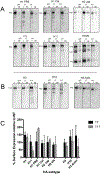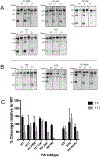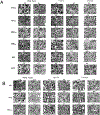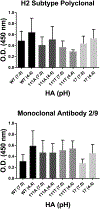A conserved histidine in Group-1 influenza subtype hemagglutinin proteins is essential for membrane fusion activity
- PMID: 31401467
- PMCID: PMC6733629
- DOI: 10.1016/j.virol.2019.08.005
A conserved histidine in Group-1 influenza subtype hemagglutinin proteins is essential for membrane fusion activity
Abstract
Influenza A viruses enter host cells through the endocytic pathway, where acidification triggers conformational changes of the viral hemagglutinin (HA) to drive membrane fusion. During this process, the HA fusion peptide is extruded from its buried position in the neutral pH structure and targeted to the endosomal membrane. Conserved ionizable residues near the fusion peptide may play a role in initiating these structural rearrangements. We targeted highly conserved histidine residues in this region, at HA1 position 17 of Group-2 HA subtypes and HA2 position 111 of Group-1 HA subtypes, to determine their role in fusion activity. WT and mutant HA proteins representing several subtypes were expressed and characterized, revealing that His 111 is essential for HA functional activity of Group-1 subtypes, supporting continued efforts to target this region of the HA structure for vaccination strategies and the design of antiviral compounds.
Keywords: Fusion; Hemagglutinin; Influenza; Virus entry.
Copyright © 2019 Elsevier Inc. All rights reserved.
Figures







Similar articles
-
A histidine residue of the influenza virus hemagglutinin controls the pH dependence of the conformational change mediating membrane fusion.J Virol. 2014 Nov;88(22):13189-200. doi: 10.1128/JVI.01704-14. Epub 2014 Sep 3. J Virol. 2014. PMID: 25187542 Free PMC article.
-
HA-Dependent Tropism of H5N1 and H7N9 Influenza Viruses to Human Endothelial Cells Is Determined by Reduced Stability of the HA, Which Allows the Virus To Cope with Inefficient Endosomal Acidification and Constitutively Expressed IFITM3.J Virol. 2019 Dec 12;94(1):e01223-19. doi: 10.1128/JVI.01223-19. Print 2019 Dec 12. J Virol. 2019. PMID: 31597765 Free PMC article.
-
Intermonomer Interactions in Hemagglutinin Subunits HA1 and HA2 Affecting Hemagglutinin Stability and Influenza Virus Infectivity.J Virol. 2015 Oct;89(20):10602-11. doi: 10.1128/JVI.00939-15. Epub 2015 Aug 12. J Virol. 2015. PMID: 26269180 Free PMC article.
-
Composition and functions of the influenza fusion peptide.Protein Pept Lett. 2009;16(7):766-78. doi: 10.2174/092986609788681715. Protein Pept Lett. 2009. PMID: 19601906 Review.
-
Unique Infectious Strategy of H5N1 Avian Influenza Virus Is Governed by the Acid-Destabilized Property of Hemagglutinin.Viral Immunol. 2017 Jul/Aug;30(6):398-407. doi: 10.1089/vim.2017.0020. Epub 2017 Jun 27. Viral Immunol. 2017. PMID: 28654310 Review.
Cited by
-
A naturally occurring HA-stabilizing amino acid (HA1-Y17) in an A(H9N2) low-pathogenic influenza virus contributes to airborne transmission.mBio. 2024 Jan 16;15(1):e0295723. doi: 10.1128/mbio.02957-23. Epub 2023 Dec 19. mBio. 2024. PMID: 38112470 Free PMC article.
-
Universal stabilization of the influenza hemagglutinin by structure-based redesign of the pH switch regions.Proc Natl Acad Sci U S A. 2022 Feb 8;119(6):e2115379119. doi: 10.1073/pnas.2115379119. Proc Natl Acad Sci U S A. 2022. PMID: 35131851 Free PMC article.
-
Viral Membrane Fusion: A Dance Between Proteins and Lipids.Annu Rev Virol. 2023 Sep 29;10(1):139-161. doi: 10.1146/annurev-virology-111821-093413. Annu Rev Virol. 2023. PMID: 37774128 Free PMC article. Review.
-
Energy Landscape for the Membrane Fusion Pathway in Influenza A Hemagglutinin From Discrete Path Sampling.Front Chem. 2020 Sep 25;8:575195. doi: 10.3389/fchem.2020.575195. eCollection 2020. Front Chem. 2020. PMID: 33102445 Free PMC article.
-
Molecular Dynamics Investigation of the Influenza Hemagglutinin Conformational Changes in Acidic pH.J Phys Chem B. 2024 Nov 14;128(45):11151-11163. doi: 10.1021/acs.jpcb.4c04607. Epub 2024 Nov 4. J Phys Chem B. 2024. PMID: 39497238 Free PMC article.
References
-
- Bizebard T, Gigant B, Rigolet P, Rasmussen B, Diat O, Bosecke P, Wharton SA, Skehel JJ, Knossow M, 1995. Structure of influenza virus haemagglutinin complexed with a neutralizing antibody. Nature 376, 92–94. - PubMed
-
- Bodian DL, Yamasaki RB, Buswell RL, Stearns JF, White JM, Kuntz ID, 1993. Inhibition of the fusion-inducing conformational change of influenza hemagglutinin by benzoquinones and hydroquinones. Biochemistry 32, 2967–2978. - PubMed
-
- Bullough PA, Hughson FM, Skehel JJ, Wiley DC, 1994. Structure of influenza haemagglutinin at the pH of membrane fusion. Nature 371, 37–43. - PubMed
Publication types
MeSH terms
Substances
Grants and funding
LinkOut - more resources
Full Text Sources
Medical
Research Materials
Miscellaneous

